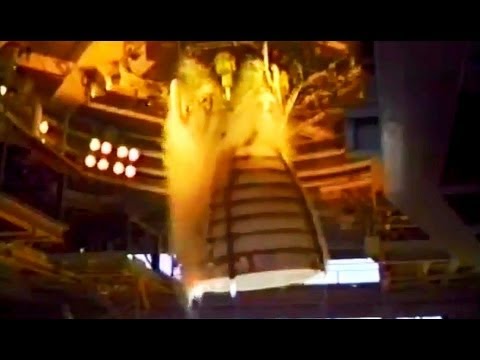more at
“The history and a description of the John C. Stennis Space Center is presented. Released January 1992.”
Public domain film from NASA, slightly cropped to remove uneven edges, with the aspect ratio corrected, and mild video noise reduction applied.
The soundtrack was also processed with volume normalization, noise reduction, clipping reduction, and/or equalization (the resulting sound, though not perfect, is far less noisy than the original).
The John C. Stennis Space Center (SSC) is a NASA rocket testing facility. It is located in Hancock County, Mississippi, on the banks of the Pearl River (Mississippi–Louisiana) at the Mississippi–Louisiana border. As of 2012, it is NASA’s largest rocket engine test facility.
As of 2007, British manufacturer Rolls-Royce plc has been operating an outdoor aero-engine test facility within SSC…
History
The initial requirements for NASA’s proposed rocket testing facility required the site to be located between the rockets’ manufacturing facility at Michoud Assembly Facility in eastern New Orleans, Louisiana and the launch facility at the Kennedy Space Center in Florida. Also, the site required barge access as the rocket motors to be tested for Apollo were too large for overland transport.
The selected area was thinly populated and met all other requirements; however before construction began, five small communities (Gainesville, Logtown, Napoleon, Santa Rosa, and Westonia), plus the northern portion of a sixth (Pearlington), and a combined population of 700 families had to be completely relocated off the facility. Remnants of the communities, including city streets and a one-room school house, still exist within the facility.
The 13,500 acres (55 km2) site was selected on October 25, 1961 on the Mississippi Test Facility or Pearl River Site. On December 18, 1961 NASA officially designated the facility as NASA Mississippi Test Operations. The test area (officially known as the Fee Area) is surrounded by a 125,000 acres (506 km2) acoustical buffer zone. The facility’s large concrete and metal test stands were originally used to test-fire the first and second stages of the Saturn V rockets. All Space Shuttle Main Engines were flight-certified at Stennis. The facility was renamed again to Mississippi Test Facility on July 1, 1965, became a part of the Marshall Space Flight Center on June 14, 1974 and renamed National Space Technology Laboratories a name that continued until May 20, 1988 when it was renamed for Mississippi senator and space program supporter John C. Stennis…
Test stands
The Engineering & Science Directorate (ESD) at SSC operates and maintains SSC’s rocket test stands.
A-1
– The A-1 test stand was originally designed to test the Apollo Saturn V Second Stage (S-II). It supports a maximum dynamic load of 1.7 M lbf.
A-2
– The A-2 test stand is used for J-2X Engine testing. It supports a maximum dynamic load of 1.1 M lbf.
A-3
– NASA has begun construction of the new A-3 test stand at SSC. The A-3 stand will be used for testing J-2X engines under vacuum conditions simulating high altitude operation. A-3 will also be operable as a sea-level test facility.
B-1/B-2
– The B-1/B-2 test stand is a dual-position stand supporting a maximum dynamic load of 11M lbf. It was originally built to simultaneously test the five F-1 engines of a complete Saturn-V S1-C first stage. During the shuttle era it was modified to test the Space Shuttle Main Engine(SSME). It is currently under retrofit for SLS main engine testing.
E-Complex
– The E-Complex supports testing of small engine and single/multiple components…
Facilities
In 2005, the Center was home to over 30 government agencies and private companies. By far the largest of these were elements of the United States Navy with some 3,500 personnel, which was far larger than the NASA civil servant contingent. Some of the prominent resident agencies include:
– The National Oceanic and Atmospheric Administration’s National Data Buoy Center
– A branch of the Naval Research Laboratory
– The Lockheed Martin Mississippi Space and Technology Center
– The Naval Meteorology and Oceanography Command
– The Naval Oceanographic Office
– Navy Special Boat Team 22 and NAVSCIATTS (Naval Small Craft Instruction and Technical Training School).
– The University of Southern Mississippi’s High Performance Visualization Center
– Rolls-Royce Outdoor Engine Testing Centre
– The US Geological Survey Hydrologic Instrumentation Facility
– Mississippi Army Ammunition Plant…

